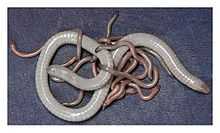Herpele squalostoma
From Wikipedia, the free encyclopedia
| Herpele squalostoma | |
|---|---|
| Conservation status | |
| Scientific classification | |
| Kingdom: | Animalia |
| Phylum: | Chordata |
| Class: | "Amphibia" (wide sense) |
| Order: | Gymnophiona |
| Family: | Herpelidae |
| Genus: | Herpele |
| Species: | H. squalostoma |
| Binomial name | |
| Herpele squalostoma (Stuchbury, 1836) | |
| Synonyms | |
|
Caecilia squalostoma Stutchbury, 1836 | |
Herpele squalostoma is a species of amphibian in the Herpelidae family. It is also known by the common name Congo caecilian.[2] It is found in Central and Western Africa (Cameroon, Central African Republic, Republic of the Congo, Democratic Republic of the Congo, Equatorial Guinea, Gabon, Nigeria, and possibly Angola). Its natural habitats are tropical moist lowland forests, plantations, rural gardens, and heavily degraded former forest.[1]

Female (length 36 cm (14 in)) with her young.
Reproduction
Herpele squalostoma is probably oviparous and provides parental care: the young feed on their mother's skin (they are "dermatophagous").[3]
References
- ↑ 1.0 1.1 Loader, S., Wilkinson, M. & Gower, D. (2004). "Herpele squalostoma". IUCN Red List of Threatened Species. Version 2013.2. International Union for Conservation of Nature. Retrieved 13 January 2014.
- ↑ Frost, Darrel R. (2013). "Herpele squalostoma (Stutchbury, 1836)". Amphibian Species of the World 5.6, an Online Reference. American Museum of Natural History. Retrieved 13 January 2014.
- ↑ Kouete, M. T.; Wilkinson, M.; Gower, D. J. (2012). "First reproductive observations for Herpele Peters, 1880 (Amphibia: Gymnophiona: Herpelidae): evidence of extended parental care and maternal dermatophagy in H. squalostoma (Stutchbury, 1836)". ISRN Zoology 2012: 269690. doi:10.5402/2012/269690.
This article is issued from Wikipedia. The text is available under the Creative Commons Attribution/Share Alike; additional terms may apply for the media files.
